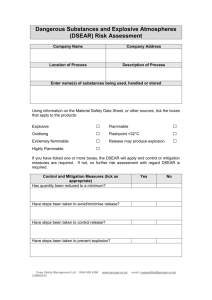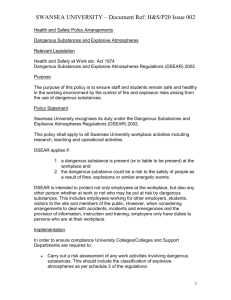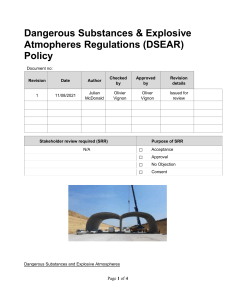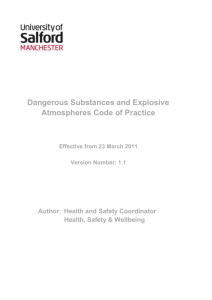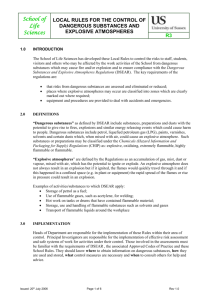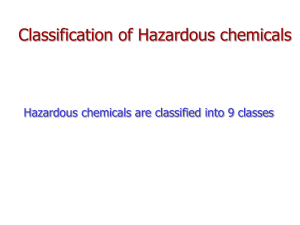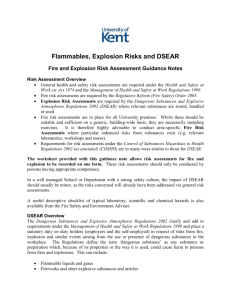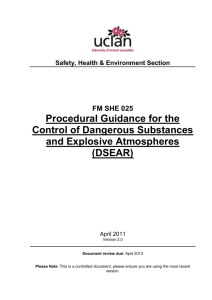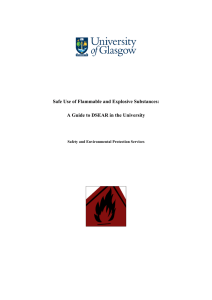DSEAR Risk Assessment Form
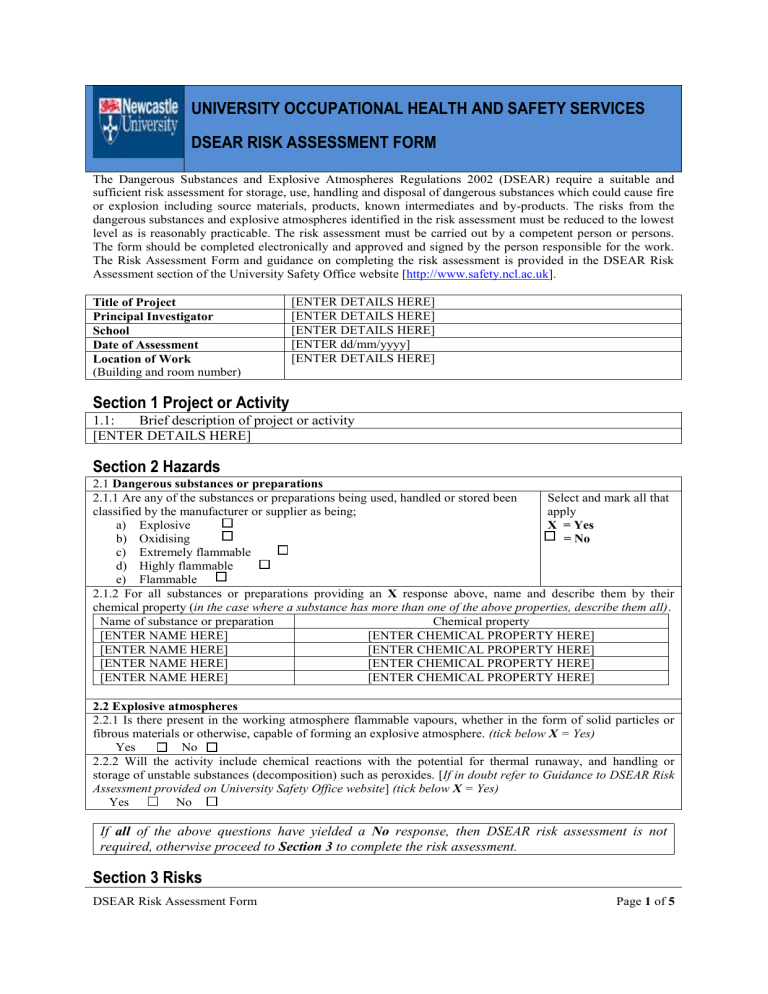
UNIVERSITY OCCUPATIONAL HEALTH AND SAFETY SERVICES
DSEAR RISK ASSESSMENT FORM
The Dangerous Substances and Explosive Atmospheres Regulations 2002 (DSEAR) require a suitable and sufficient risk assessment for storage, use, handling and disposal of dangerous substances which could cause fire or explosion including source materials, products, known intermediates and by-products. The risks from the dangerous substances and explosive atmospheres identified in the risk assessment must be reduced to the lowest level as is reasonably practicable. The risk assessment must be carried out by a competent person or persons.
The form should be completed electronically and approved and signed by the person responsible for the work.
The Risk Assessment Form and guidance on completing the risk assessment is provided in the DSEAR Risk
Assessment section of the University Safety Office website [ http://www.safety.ncl.ac.uk
].
Title of Project
Principal Investigator
[ENTER DETAILS HERE]
[ENTER DETAILS HERE]
School
Date of Assessment
[ENTER DETAILS HERE]
[ENTER dd/mm/yyyy]
Location of Work
(Building and room number)
[ENTER DETAILS HERE]
Section 1 Project or Activity
1.1: Brief description of project or activity
[ENTER DETAILS HERE]
Section 2 Hazards
2.1 Dangerous substances or preparations
2.1.1 Are any of the substances or preparations being used, handled or stored been classified by the manufacturer or supplier as being; a) Explosive b) Oxidising c) Extremely flammable d) Highly flammable e) Flammable
Select and mark all that apply
X = Yes
= No
2.1.2 For all substances or preparations providing an X response above, name and describe them by their chemical property ( in the case where a substance has more than one of the above properties, describe them all) .
Name of substance or preparation
[ENTER NAME HERE]
[ENTER NAME HERE]
[ENTER NAME HERE]
Chemical property
[ENTER CHEMICAL PROPERTY HERE]
[ENTER CHEMICAL PROPERTY HERE]
[ENTER CHEMICAL PROPERTY HERE]
[ENTER CHEMICAL PROPERTY HERE] [ENTER NAME HERE]
2.2 Explosive atmospheres
2.2.1 Is there present in the working atmosphere flammable vapours, whether in the form of solid particles or fibrous materials or otherwise, capable of forming an explosive atmosphere. (tick below X = Yes)
Yes No
2.2.2 Will the activity include chemical reactions with the potential for thermal runaway, and handling or storage of unstable substances (decomposition) such as peroxides. [ If in doubt refer to Guidance to DSEAR Risk
Assessment provided on University Safety Office website ] (tick below X = Yes)
Yes No
If all of the above questions have yielded a No response, then DSEAR risk assessment is not required, otherwise proceed to Section 3 to complete the risk assessment.
Section 3 Risks
DSEAR Risk Assessment Form Page 1 of 5
3.1 The risk of fire, explosion or similar energetic event
3.1.1Describe below how in relation to physical and chemical properties of the substances or preparations being handled or stored the activity can lead to fire or explosion.
[ENTER DETAILS HERE]
3.2 Ignition sources
3.2.1 Is the working area free from any potential sources of ignition such as Bunsen burners, hot plates, ovens, furnaces or heating equipment?
[ENTER DETAILS HERE]
3.3 Who might be at risk
Staff Students Visitors Public
[ENTER DETAILS HERE]
3.4 Assessment of risk (prior to use of controls)
3.4.1 What is the overall level of risk for the activity? [ Refer to the Risk Estimation Matrix at the end of this form ]
Effectively zero Low Medium High
Section 4 Controls to eliminate or reduce risks to as low as possible
Note: If your response to any of the following questions is No, consult the University Occupational Health and Safety
Services office or refer to the DSEAR Risk Assessment Guidance provided at the University Safety Office Website.
4.1 Elimination or reduction of risks from dangerous substances
4.1.1 Have steps been taken to control releases at source or reduce the quantity of the dangerous substance stored or used to a minimum?
Yes No
[ENTER DETAILS HERE]
4.1.2 Have steps been taken to avoid, or minimise releases that may lead to formation of explosive atmosphere under normal and accidental conditions?
Yes No
[ENTER DETAILS HERE]
4.1.3 Have any other measures such as substitution of dangerous substances or preparations, avoidance of ignition sources or explosive atmospheres been considered to eliminate or reduce risks from dangerous substances?
Yes No
[ENTER DETAILS HERE]
4.1.4 Has the number of people who may be at risk in the event of a fire or explosion been reduced to a minimum?
Yes No
[ENTER DETAILS HERE]
4.2 Places where explosive atmospheres may occur
4.2.1 Has the work area (laboratory or stores), where explosive atmospheres may be present been verified as being appropriate, by a competent person? [ Refer to DSEAR Risk Assessment Guidance on the University Safety
Office Website ]
Yes No
4.2.2 Is the workplace so designed, constructed and maintained so as to provide adequate fire-resistance and/or explosion relief? [ If in doubt consult the University Safety Office /University Fire Officer /Estates ]
Yes No
[ENTER DETAILS HERE]
4.2.3 Have steps been taken to collect, contain or remove any releases to a safe place (e.g. ventilation) or avoid adverse conditions (e.g. exceeding temperature limits or other control settings) ?
Yes No
[ENTER DETAILS HERE]
4.2.4 Are any assembly, work process, construction, installation, rig, plant, equipment, protective equipment system, etc., designed, used and maintained in a manner so as to reduce fire and/or explosion risks?
Yes No
[ENTER DETAILS HERE]
4.3 Identification of hazardous contents of containers and pipes
Page 2 of 5 DSEAR Risk Assessment Form
4.3.1 Have all stores of dangerous substances been appropriately marked to indicate and provide warning of their contents?
Yes No
4.3.2 Have all such areas been classified as hazardous or non hazardous zones. Where areas have been classified as hazardous zones, have such areas been marked at their entry points with the specified ‘EX’ hazard warning sign?
Yes No
4.3.3 Are all areas classified as hazardous zones appropriately protected from sources of ignition, through the selection of equipment and appropriate protective clothing that does not create a risk of electrostatic discharge?
[ If in doubt consult to the DSEAR Guidance on the University Fire Safety Officer ]
Yes No
4.3.4 Are supply and discharge terminals clearly and permanently marked at each end and along the pipe run to identify the liquid or gas carried?
Yes No
4.3.5 Are pipes colour-coded throughout their length and clearly marked to show the direction of flow of the contents?
Yes No
4.3.6 Is pipework passing through compartment walls and floors protected in accordance with the design guide for the protection of buildings? [ If in doubt consult the University Fire Safety Officer ]
Yes No
4.3.7 Do pipelines take the shortest practical route and are they located and adequately supported well clear of heat sources, electric cables and other services or areas where mechanical damage is possible?
Yes No
4.4 Handling, storage and disposal of dangerous substances
4.4.1 Are all flammable substances including petroleum spirits or derivatives thereof, kept in suitable fire resistant storage and are all quantities of flammable substances in excess of 50L kept in dedicated and appropriately protected flammable stores?
Yes No
4.4.2 Are incompatible substances stored apart (e.g. flammables, oxidisers, combustibles, flammable gases,
LPG) and where appropriate, have such storage areas been designed to provide explosion relief or resistance?
Yes No
4.4.3 Have safe use, handling, storage and disposal procedures been developed, documented and communicated to personnel? Are such procedures, including precautions in case of spills and leaks readily available in the work and store rooms?
Yes No
4.4.4 Have steps been taken to contain or minimise escape of vapours and any spillages or loss of containment?
Yes No
4.4.5 Are flammable liquids and gases that are delivered from cylinders or bulk tanks located safely outside the building via permanently installed hard metal piping with quick-action isolation valves linked to the automatic fire detection system installed both at the point of supply and delivery?
Yes No
4.4.6 Are cylinders containing flammable liquids and gases stored in a secure compound in the open air to enable natural ventilation to disperse leaks?
Yes No
[ENTER DETAILS HERE]
4.4.7 Are cylinders containing flammable gases secured in a vertical position, preferably within a cabinet providing at least 60-minutes’ fire resistance with appropriate hazard warning signs displayed prominently? [ If in doubt consult the University Fire Safety Officer ]
Yes No
[ENTER DETAILS HERE]
4.4.8 Has the use of acetylene been minimised with the cylinders safely stored outside the building or in a separate fire compartment?
Yes No
[ENTER DETAILS HERE]
4.4.9 Are unauthorised access, smoking and naked lights prohibited in all flammable gas storage areas and buildings, and permanent warning notices prominently displayed?
Yes No
DSEAR Risk Assessment Form Page 3 of 5
[ENTER DETAILS HERE]
4.4.10 Are different types of gases segregated from each other, particularly flammable gases and oxidising gases? Are empty cylinders kept segregated from full cylinders with all cylinders being protected from direct sunlight?
Yes No
[ENTER DETAILS HERE]
4.4.11 Have suitable procedures been developed and communicated to personnel and implemented to deal with the safe transport and disposal of dangerous substances? [ If in doubt consult the University Dangerous Goods
Safety Advisor ]
Yes No
[ENTER DETAILS HERE]
4.4.12 Are there arrangements for storage and disposal of flammable waste materials?
Yes No
[ENTER DETEAILS HERE]
4.5 Arrangements for dealing with accidents, incidents or emergencies
4.5.1 Is explosion suppression or relief provided on equipment?
Yes No
[ENTER DETAILS HERE]
4.5.2 Have fire detection and fire alarm systems been provided and are the locations for fire alarm assembly points been clearly marked?
Yes No
4.6 Information, instruction and training
4.6.1 Has appropriate information instruction and training been provided to personnel as regards; product detail, hazard, risk reduction methods to be employed, management systems to be followed, emergency systems, etc.?
Yes No
[ENTER DETAILS HERE]
4.6.2 Have appropriate safe systems of work, or other required procedural systems of organising work been developed and communicated to personnel either by this form or some other documentation?
Yes No
[ENTER DETAILS HERE]
4.6.3 Is a permit to work scheme for working with dangerous substances and preparations, or working in areas with potentially explosive atmospheres in place, and these strictly enforced?
Yes No
Section 5 Emergency Procedures
5.1 Have suitable emergency procedures been developed and communicated to personnel to deal with adverse process conditions (e.g. exceeding limits of temperature, or other control settings)?
Yes No
[ENTER DETAILS HERE]
5.2 Have suitable emergency procedures been developed and communicated to personnel to deal with fire and evacuation?
Yes No
[ENTER DETAILS HERE]
5.3 Have suitable emergency procedures been developed and communicated to personnel to deal with a spillage and/or leakage of dangerous substances?
Yes No
[ENTER DETAILS HERE]
5.4 Have emergency escape routes and exits been clearly identified and marked, and are they kept clear and unobstructed at all times?
Yes No
5.5 Emergency contacts
Name
[ENTER DETAILS HERE]
[ENTER DETAILS HERE]
Position
[ENTER DETAILS HERE]
[ENTER DETAILS HERE]
Telephone
[ENTER NUMBER HERE]
[ENTER NUMBER HERE]
Page 4 of 5 DSEAR Risk Assessment Form
Where any questions relevant to a dangerous substance being used, produced, handled or stored has returned a ‘No’ response, the subject area should be revisited to ensure that all required and reasonably practicable risk reducing methods have been implemented.
Section 6 Approval
6.1 Assessor
Name
6.2 Principal investigator
Name
Risk Estimation Matrix
Signature
Signature
Date
Date
Severity of harm
Severe
Moderate
Minor
Negligible
Likelihood of harm
High
High
High
Medium
Low
Medium
High
Medium
Low
Effectively zero
Low
Medium
Low
Low
Effectively zero
Negligible
Low
Effectively zero
Effectively zero
Effectively zero
DSEAR Risk Assessment Form Page 5 of 5
